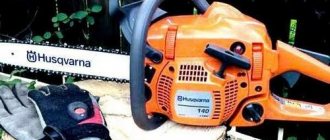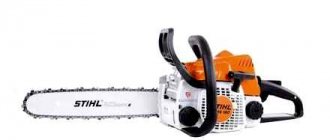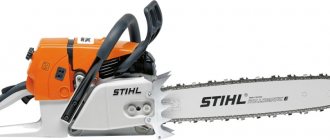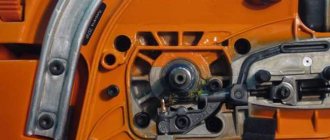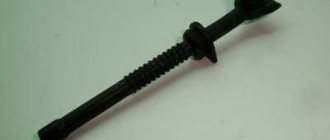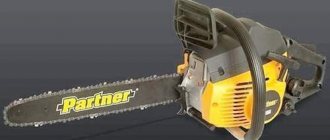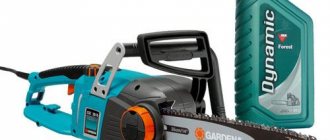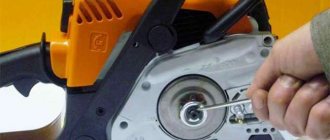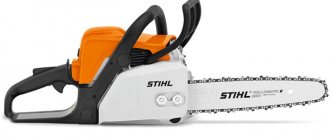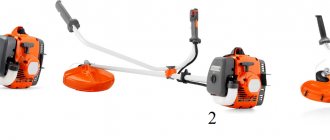Chainsaw chain lubrication system
To supply oil to lubricate the chainsaw chain, the tool uses a special pump, which delivers lubricant to the saw bar in a dosed manner, depending on the number of engine revolutions.
The system uses oil to lubricate the chainsaw chain, which has increased adhesive properties; this is necessary for uniform distribution of oil along the entire perimeter of the bar and retention on it even at high rotation speeds of the chain. Let's take a closer look at the oil supply system implemented in modern chainsaws.
The oil on the chain saw does not flow into the chain.
This function is very convenient, as it saves your money and does not waste excess oil.
Pump structure, lubrication system and principle of operation
The oil pump drive consists of two parts: a plastic worm gear and a wire lever that transmits force from the drum sprocket to the worm gear.
The lever is aggressively mounted on the pinion and they are supplied as one piece. The tip of the wire arm has a suitable curvature designed to best grip the drive sprocket drum. The drum has a special connector for installing a drive.
The Stihl 100 oil pump is eight hundred percent iron and has a one-piece design. The pump housing has an oil inlet and a groove channel through which oil from the oil line directly enters the pump. The mechanism is installed in the body of a Stihl 180 chainsaw.
When the engine speed increases, the sprocket drum begins to rotate the worm gear by the wire lever, and this, in turn, forces the oil pump plunger to rotate, as a result of which oil begins to be pumped through the oil channels. To the chainsaw bar.
The oil line of the chainsaw, at the end of which there is an oil receiver, also plays a specific role in the operation of the system. Oil receiver. This is an additional filter. On the second side of the oil hose there is a rubber expander, with which the hose is installed into the body of the Stihl 100 eighty chainsaw immediately behind the oil pump.
Running in a Stihl MC one hundred and eighty chainsaw - tips for beginners
The purchased Stihl chainsaw in the MS 100 eighty configuration needs to be rolled up. This will make it possible to grind in the parts of the tool for the upcoming coordinated operation of the main saw devices.
Before starting your Stihl 100 eighty chainsaw, fill it with the latest fuel mixture. You will also need to add fresh oil to lubricate the chain of the Stihl 180 chainsaw. The next procedure is as follows:
- First, you need to release the chain brake to eliminate the risk of the body melting at the clutch installation site. The brake will also protect the operator from possible damage;
- Then start the saw and let it run for fifteen minutes. In this case, you need to press the gas lever every thirty seconds;
- After this, you need to put the saw back into operation as usual. At this time, you should begin sawing thin branches, gradually moving on to working with larger branches.
»As a rule, preparing the instrument takes no more than 30–35 minutes. During break-in and further operation of the Stihl MS one hundred and eighty saw, you must constantly ensure that nails and other hard objects do not fall under the chain.
Chainsaw pump repair
It is believed that repairing a chainsaw oil pump with your own hands is quite problematic. In fact, if you have basic locksmith skills and general rotation concepts and mechanisms, you can easily restore it to its original settings. To do this, prepare the following tools and accessories:
- Set of figured and flat screwdrivers;
- Open-end and socket wrenches;
- Rags.
To troubleshoot the pump, it is necessary to dismantle it without touching the working part.
Installed oil pump on chainsaw
There must be a sealing gasket between the two halves of the unit, which will need to be replaced with a new one in the presence of gusts of wind and elevation changes. The next step is to check the integrity of the supply hose. There should be no diaper rash or cracks on its cylindrical generatrix, which in the future may lead to loss of tightness of the system. If such mowing lines are found, they should be replaced and a good hose should be washed and sealed to the ends of the tank and pump.
The output channels of the oil pump must be free of foreign matter (dust, chips, dirt). Such blockages can lead not only to deterioration of the lubrication process, but also to the formation of vacuum plugs that can damage the supply lines.
Why does the spark plug on a Stihl 180 chainsaw flood?
The essence of this breakdown lies in problems with the carburetor. To repair, you will need to remove this element and also check its membrane. In working condition, the part must not only be intact, but also elastic. If the membrane has hardened, it will need to be replaced.
READ Loss of power of the STIHL 180 chainsaw under load
Before reassembling the Stihl MS one hundred and eighty carburetor, it must be cleaned of dust and carbon deposits. To do this, use compressed air in a cylinder. After the assembly has completely dried, it can be assembled and installed back on the chainsaw.
Checking the ignition system
Chainsaw ignition system
If the tool does not start, the problem may be hidden in the starter mechanism or ignition system. If the starting device is working normally, then you need to carefully inspect the spark plug. It needs to be unscrewed and carefully inspected.
Particular attention should be paid here to the electrodes, on which plaque may accumulate. If there is a red-brown coating on the electrodes, this indicates a serious malfunction of the entire starting system. This means that the cause of the malfunction may lie in the carburetor.
If the ignition system is working properly but the tool is not working properly, the problem may be due to too much air/fuel mixture. Here you need to adjust the carburetor and clean the jets.
Do-it-yourself carburetor adjustment with a chainsaw
If, upon inspection, carbon deposits are found on the spark plug, it means that the tool runs on low-quality gasoline. This could also be caused by a faulty carburetor.
To resolve such an issue, you need to take the following steps:
- Remove the carburetor and check it;
- Clean and adjust if necessary;
- Replace fuel;
- Install the carburetor and check the tool in operation.
It is worth noting here that the carburetor. quite a complex unit. Therefore, if there is a need to repair it, it is better to seek help from specialists.
And in this article you can learn how to make a hand-held garden auger.
With this information, you can repair the Stihl one hundred and eighty chainsaw at home. Of course, you need to take into account that it is better to fix more serious faults in service centers.
See an overview of the diagnostics of the lubrication system of the Stihl MS180 chainsaw:
Chainsaw chain lubrication system
To supply oil to lubricate the chainsaw chain, the tool uses a special pump, which supplies lubricant to the saw bar in a dosed manner, depending on the engine speed.
The chainsaw chain lubrication system uses oil that has increased adhesive properties; this is necessary to evenly distribute the oil along the entire perimeter of the bar and keep it on it even at high chain speeds. Let's take a closer look at the oil supply system implemented in modern chainsaws.
What to do if there is no oil supply to the chain of the Stihl 180 chainsaw?
If the chain on a German Stihl MS one hundred and eighty saw is not lubricated, this indicates a blockage or malfunction of the line through which the oil circulates. To fix the problem, you will need to remove the tool handle, pull out the hose, and clean it. After this, the hose must be installed back on the saw, and the installation site must be lubricated with sealant.
Another reason for oil failure. there is a blockage in the Stihl MS 180 pump. To correct the situation, you will need to remove the pump and wash it with clean gasoline. If this does not help, the part will need to be replaced.
Oil does not flow to the chainsaw chain: causes and solutions
When the saw chain of a chainsaw moves, a large amount of heat is generated in the bar groove due to friction. If oil does not flow to chain , it is necessary to stop work and take all measures to eliminate the malfunction of the lubrication system. The combination of heavy loads and overheating of the headset is accompanied by its accelerated wear and premature failure.
- All chainsaws and their electric analogues, without exception, are equipped with the same type of systems based on the principle of operation, with the help of which the bar, saw chain and its drive parts lubricated
- This unit is supplied as standard with a reservoir from which chain oil is supplied to the inlet of a fixed or variable displacement pump.
- Next, the working fluid in a dosed amount enters the tire groove, in which the saw chain shanks are evenly distributed throughout the headset and the working surface of the drive sprocket crown.
Four hundred mm long Performance Headset tires are equipped with a driven sprocket. Periodic lubrication of bearings is carried out individually, after 6-8 hours of operation.
Advantages of higher class oil pumps
The maintainability of dismountable pumps is sufficient to restore the unit’s functionality at home.
The pump drive gears of budget chainsaws are mostly polymer. Branded models of variable performance, advanced in technical equipment, are equipped with drive mechanisms made of non-ferrous metals. The cost of such systems is compensated by the economical consumption of up to 50% of the working fluid.
Lubrication system design
Depending on the brand of chainsaw, the parts of the lubrication system may vary slightly in design, but their total number and connection diagram remain the same.
The main components of the lubrication system are:
- an oil tank located, as a rule, in the engine crankcase.
- The filter element is installed in the tank.
- The oil line is a small diameter hose made of oil-resistant rubber.
- The heart of the system is the oil pump.
- The worm gear transmits force from the engine to the pump.
- The chainsaw tire can also be considered an element of the lubrication system, since it has special holes for supplying oil. By the way, the chain itself is involved in transporting oil and, accordingly, also has some elements designed specifically to provide lubrication.
Principle of operation
The main unit of the system is the pump. The principle of its operation is as follows. As engine speed increases, a gear mounted on the main shaft drives the pump shaft through a worm gear. In turn, the rotation of the shaft creates a certain pressure in the oil line, which forces the oil to move along it towards the tire.
The end of the oil channel is located at the point of contact of the tire with the tool housing, where there is a longitudinal groove into which, when installing the tire, its oil channel falls.
The groove is necessary to ensure the supply of oil to the bar, regardless of the degree of tension of the chainsaw chain. Simply put, no matter what position the tire is in at the time of operation, oil will get onto it through the groove.
Next, the lubrication process includes a chain, on the links of which, depending on the chain model, there is either a groove or a hole through which the oil is dispersed throughout the tire. As engine speed increases, the oil flow rate also increases.
Some models of chainsaws are equipped with pumps that additionally have capacity adjustment, and if necessary, the amount of oil supplied by the lubrication system can be increased or decreased.
This function is quite convenient, because it allows you to save money and not waste extra oil.
Lubrication system malfunctions and how to fix them
The main malfunctions of the oil supply system on a chainsaw can be divided into two main types: these are general malfunctions inherent in all chainsaws and individual ones, which may vary depending on the type of pump and worm gear installed on a particular model. Let's begin to understand the faults in order.
Operating a chainsaw without lubricating the chainsaw chain is prohibited. This has a detrimental effect on the bar, drive sprocket and chain, and can result in significant repair costs.
Signs of a malfunction of the lubrication system, checking its performance
- The chainsaw chain is dry and has a pale tint without shine.
- The chain stretches relatively quickly.
- The tire is very hot and may even partially melt the paint.
- The oil from the tank is practically not reduced.
- Reduced cutting efficiency on a sharp chain
All these signs indicate that the lubrication process is not proceeding properly. In order to check the oil supply to the lubrication system, you need to remove the side tire of the chainsaw and start it. Next, you need to slightly increase the speed while observing the end of the oil line. If oil comes in, most likely the amount is not enough for normal lubrication and you need to clean or replace the filter and, if possible, adjust the flow. If it does not, the problem is more serious and requires further diagnosis.
There is a way to check the oil supply without removing the tires. To do this, you need to point the end of the bar towards, for example, a freshly cut piece of wood from the side of the cut and increase the speed as much as possible, while trying to keep the end of the bar at a distance of no more than 10 cm from the block. If oil spots begin to appear on its surface, it means the oil is being supplied.
Troubleshooting
Once it has been determined that oil is not being supplied, further diagnosis is only possible if the oil system is completely removed. Of course, in some situations replacing the filter helps, but this is very rare.
Access to the oil pump of some models of saws is possible only after complete disassembly; therefore, without having the skills to repair gas-powered tools, it is better to entrust repairs to professionals.
Most common faults
- Broken oil hose. It can sometimes be detected by visual inspection. The problem is solved by replacing the faulty part.
- There is no thread on the oil pump shaft; replacing it will help.
- A defective thread on the pump drive gear can be similarly solved by installing a new part.
- Lack of main shaft corkscrew (relevant for some instrument models, for example, Homelite). You can fix it by installing a nail of a suitable diameter instead of the original corkscrew, cutting it to the required length.
- Blockage in the line. Can be removed by blowing with compressed air or mechanically, using a wire of a suitable diameter.
- Filter element clogged.
- The Stihl MS 180 tool, whose pump is not dismountable, often gets clogged. You can try to wash it in clean gasoline, if that doesn’t help, replace it.
- In Chinese chainsaws (Gypsy), it very often cuts off the grooves on the main gear, through which the force from the sprocket is transmitted to it.
Individual malfunction of the Stihl MS 180 lubrication system
Due to the fact that the Stihl MS 180 is one of the most common models of chainsaws, I would like to dwell in more detail on one fault inherent only to it and describe a method for eliminating it without replacing parts.
Quite often, on the Shtil MS 180 chainsaw, depressurization of the oil line is observed in the place where the oil line coming from the tank is installed in the saw body. The malfunction can be determined by the characteristic lubricant leaks on the bottom of the tool.
To eliminate the problem, you need to remove the chainsaw handle, remove the hose from the mounting hole, clean and degrease. After all these manipulations, apply sealant to the hose seat and install it into the chainsaw body.
You can learn more about troubleshooting and complete diagnostics of the lubrication system of the Stihl chainsaw by watching a video that shows the step-by-step process of disassembling and repairing the lubrication system.
Repair of STIHL MS 180 chainsaw. No oil supply.
The main reasons why stihl
180.
Chainsaw fuel system: 1. fuel filter, 4.5. carburetor, 3. manual preparatory pump.
Slowly reduce fuel consumption over the life of the saw. an ordinary process. If it is missing, the circuit
It is not lubricated correctly, so it will work perfectly with the chainsaw. It is necessary not only to be able to fix breakdowns, but also to identify them without the help of others.
It is possible to manually change the fuel consumption. The correct operation of the lubrication complex of accounting programs is determined by the method of driving the tire. If oil splashes occur, it means that what remains for our client to do is set correctly.
During operation of the chainsaw, it is necessary to constantly monitor the lubrication of the chain. Since this part works in the most demanding conditions. Chain
is subjected to constant overheating, dust and abrasive particles become clogged there.
This has a bad effect on its service life. A special lubricant will help improve the situation.
The chain is supplied to the chain from the tank, which ensures uninterrupted operation. If lubrication does not occur during operation, there is a high possibility of overheating. When no oil is supplied, the chain
begins to stretch. With all this, the possibility of it jamming or spontaneously jumping off remains, and as a result, a person can get seriously injured.
The channels through which fuel is supplied can be clogged with small particles, so it is advisable to clean them from time to time. Be sure to check the oil level in the reservoir. Debris in the air duct. A common cause of chain brake failure. This could be bad for your work.
Constant cleaning of the channels and general maintenance of the chainsaw will allow the tool to work for a long time.
The current condition of the chainsaw can only be assessed using special equipment. If you lack knowledge or lack confidence in your own abilities, it is better to entrust instrument repair to a specialist.
Real repairs on your own to lubricate a chainsaw chain in all aspects require knowledge of the interaction of all parts, which allows you to keep records (software), the availability of tools and the abilities of the mechanic.
Restoring the functionality of many chainsaws involves partial or complete dismantling of the component equipment. It is better to use the abilities and technical potential of service workshops to carry out complex repair work.
Parts with stripped threads and bent spline joints, as well as non-separable structures, which are equipped with a lubrication system for the beloved Stihl 100 eighty chainsaws and other models of the same type, change.
If, when filling the tank, oil does not enter the headset structure, the reason should be found in the pump itself. Disassembling and disassembling the mechanism will help identify faulty parts and remove the fault by replacing them.
Considering the types of defects in the lubrication system, two categories can be distinguished:
- General breakdowns of all types of power units;
- Personal ones, which depend on the type of pump, on the features of the worm gear, on the design and other features of a particular chainsaw.
“Symptoms” of a faulty lubrication system:
- The chain mechanism is dry, pale, no shine;
- The chain quickly stretched after installation;
- The guide bar heats up and the paint on it melts;
- The oil remains in the tank in the same volume, despite the intense operation of the tool;
- The efficiency of chain cutting is significantly reduced.
How to check this node? It's simple.
- Remove the side tire.
- Let's launch the tool.
- We increase the speed evenly, respecting the end of the oil line.
If consumables arrive, then the cause of the problematic operation of the lubrication unit most likely lies in a clogged filter, which can be cleaned or replaced with a new one. If possible, after this manipulation the supply of consumables is regulated.
If the consumable has not arrived, then it is necessary to carry out additional diagnostics, because, most likely, the problem is more serious.
Please note that it is not always necessary to remove the tire to check the lubrication system. Alternatively, point the end of the bar away (use a pad) from the direction of the cut, maximizing speed by keeping the bar (its end) 10cm away from the pad. You will see the proper points when oil is supplied.
READ DIY Grinding Machine
The main malfunctions of the chain saw oil supply system can be divided into two main types: these are general difficulties inherent in all chain saws, and individual ones, which may vary depending on the type of pump and worm gear installed on a particular model. Let's begin to understand the dilemmas in order.

